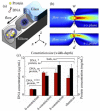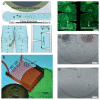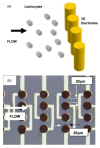Review of Microfluidic Methods for Cellular Lysis
- PMID: 33925101
- PMCID: PMC8145176
- DOI: 10.3390/mi12050498
Review of Microfluidic Methods for Cellular Lysis
Abstract
Cell lysis is a process in which the outer cell membrane is broken to release intracellular constituents in a way that important information about the DNA or RNA of an organism can be obtained. This article is a thorough review of reported methods for the achievement of effective cellular boundaries disintegration, together with their technological peculiarities and instrumental requirements. The different approaches are summarized in six categories: chemical, mechanical, electrical methods, thermal, laser, and other lysis methods. Based on the results derived from each of the investigated reports, we outline the advantages and disadvantages of those techniques. Although the choice of a suitable method is highly dependent on the particular requirements of the specific scientific problem, we conclude with a concise table where the benefits of every approach are compared, based on criteria such as cost, efficiency, and difficulty.
Keywords: cell lysis; cell membrane; microfluidics; review.
Conflict of interest statement
The authors declare no conflict of interest.
Figures




























References
-
- Nguyen N., Wereley S. Fundamentals and Applications of Microfluidics. Artech House Publishing; Norwood, MA, USA: 2007.
-
- Islam M.S., Aryasomayajula T.A., Selvaganapathy P.R. A Review on Macroscale and Microscale Cell Lysis Methods. Micromachines. 2017;8:83. doi: 10.3390/mi8030083. - DOI
-
- Nandagopal M.S.G., Nakkeeran E., Prasanna V.R., Selvaraju N.N. Advance Microfluidic Approach over Conventional Batch and CTR for Improving the Efficiency of E-coli Cell Lysis by CuO Nanoparticles. Int. J. Chem. React. Eng. 2016;15:20160105. doi: 10.1515/ijcre-2016-0105. - DOI
Publication types
LinkOut - more resources
Full Text Sources
Other Literature Sources

